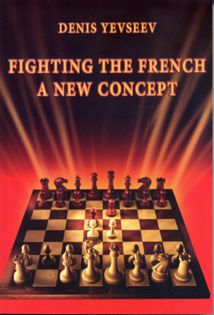Fighting The French
A New Concept
Denis Yevseev

FIGHTING THE FRENCH: A NEW CONCEPT by GM Denis Yevseev is not your normal book on the Tarrasch variation (3.Nd2). Consider that he often has White wait a long time to play the advance e5, if he plays it at all even against 3…Nf6.
How many books on the French do you know of that spend almost 100 pages on positions that almost always arise from the Nimzo-Indian or the Panov-Botvinnik variation of the Caro-Kann? FIGHTING THE FRENCH: A NEW CONCEPT is one that does.
GM Yevseev advocates a new method of development to meet the French in which White plays 3.Nd2 and then deploys his pieces according to the scheme Ngf3, Bd3, c3, 0-0, against almost anything that Black may try. The play that arises tends to be of a more strategic nature with ideas and plans predominating over long forced analysis. This said the play, which often ends up in IQP positions, packs plenty of punch.
Consider the following miniature won by one of the pioneers of this system, GM James Plaskett, against one of the worlds best.
1.e4 e6 2.d4 d5 3.Nd2 Be7 4.Ngf3 Nf6 5.Bd3 c5 6.c3 Nc6 7.00 dxe4 8.Nxe4 cxd4 9.cxd4 00 10.Nc3!? Nb4 11.Bb1 b6 12.Re1 Bb7 13.Ne5 Nbd5 14.Qd3 Rc8 15.Qh3! Nxc3 16.bxc3 Qd5 17.Bd2 g6 18.Bc2 Qa5 19.Qh4 Rxc3 20.Bb3! Nd5 21.Qh6 Bb4 22.Nd7! Rd8 3.Bxd5 Rxd7 24.Rxe6! fxe6 25.Bxe6+ Kh8 26.Bxc3 Rd8 27.Qf4, 1-0, Plaskett vs. Short, Great Britain 2000.
The breakdown of the material in this book is as follows:
Part 1. The Rubinstein Variation
1.e4 e6 2.d4 d5 3.Nd2 dxe4 4.Nxe4
4…Nf6
4…Bd7
4…Nd7
Part 2. All Other Black Replies
1.e4 e6 2.d4 d5 3.Nd2
3…g6; 3…b6; 3…Ne7
3…Nc6 4.Ngf3 Nf6 5.e5 Nd7 6.Be2
3…Be7 4.Ngf3 Nf6 5.Bd3 c5 6.c3 Nc6 7.0-0
3…h6; 3…a6
3…c5 4.c3
3…Nf6 4.Bd3
Part 3. The Isolated Queens Pawn
3…Nf6 4.Bd3 с5 5.c3 Nc6 6.Ngf3 cxd4 7.cxd4 dxe4 8.Nxe4 Be7 9.0-0 0-0
10.Nc3 and 10.Be3
3…Nf6 4.Bd3 с5 5.c3 Nc6 6.Ngf3 cxd4 7.cxd4 dxe4 8.Nxe4 Bb4+ 9.Nc3 0-0 10.0-0 b6 11.a3 Be7 12.Re1 Bb7 13.Bc2
3…c5 4.c3 cxd4 5.cxd4 dxe4 6.Nxe4 Bb4+7.Nc3 Nf6 8.Bd3 0-0 9.Nf3 b6 10.0-0 Bb7 11.Re1
3…a6 4.Ngf3 c5 5.c3 Nc6 6.Bd3 cxd4 7.cxd4 dxe4 8.Nxe4 Bb4+ 9.Nc3 Nf6 10.0-0 0-0 11.a3 Be7 12.Re1
3…a6 4.Ngf3 c5 5.c3 Nc6 6.Bd3 cxd4 7.cxd4 dxe4 8.Nxe4 Be7 9.0-0 Nf6 10.a3
3…a6 4.Ngf3 c5 5.с3 cxd4 6.cxd4 dxe4 7.Nxe4 Nd7 8.Bd3 Ngf6 9.0-0 Be7 10.Ne5
3…c5 4.c3 Nc6 5.Ngf3 cxd4 6.cxd4 dxe4 7.Nxe4 Bb4+ 8.Nc3 Nge7 9.Bd3 Nd5 10.0-0
Following the Chess Stars system, the material is laid out in a very methodical fashion that facilitates learning. First an overview is offered (Quick Repertoire), then the material is carefully examined (Step by Step) and finally deeply annotated games with lots of prose commentary completes the presentation of the theory (Complete Games).
This is a good approach that works well for players of different levels. Less experienced players and new comers to the system will want to go to Quick Overview and the Complete Games sections first while experienced users may be inclined to head straight to Step by Step.
The system Ngf3, Bd3, c3, 0-0, leads to more open play than one normally associates with the Tarrasch French and those wishing to construct a cohesive opening repertoire for White based on 1.e4 will find that it meshes well with the Panov-Bovinnik Attack against the Caro-Kann and to a lesser extent 2.c3 versus the Sicilian (some of the IQP positions that occur after 2 …d5 are common to both openings).
GM Yevseev has done an outstanding job with this original work.
Highly Recommended
